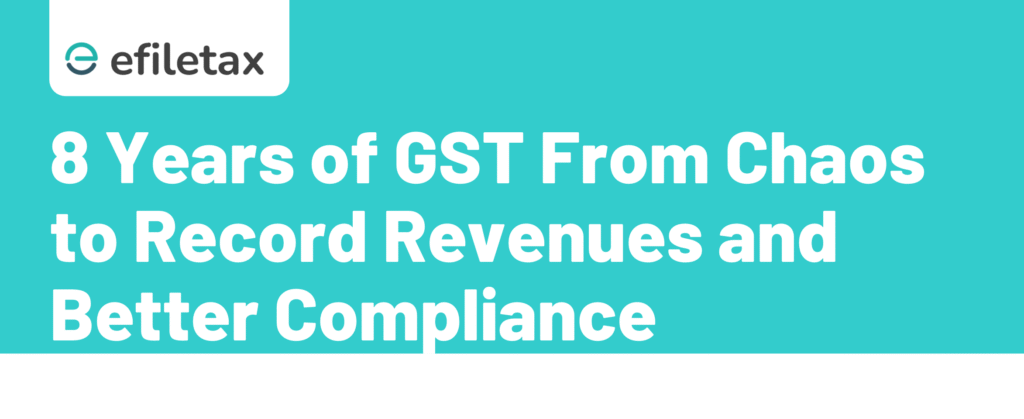
GST Turns 8: Impact on Tax Collections & Compliance
The Goods and Services Tax (GST) has completed 8 years since its historic rollout on 1st July 2017. What began as a bold reform to unify India’s complex indirect tax system has now matured into a robust, technology-driven regime showing record GST collections and improved compliance.
Let’s break down what this milestone means for Indian taxpayers and the economy.
What is GST? A Quick Recap
The GST system replaced multiple indirect taxes like VAT, service tax, excise duty, and more. It created a unified national market with the principle of One Nation, One Tax. GST is levied on the supply of goods and services, and is structured as:
- CGST (Central GST)
- SGST (State GST)
- IGST (Integrated GST for inter-state transactions)
Key GST Milestones Over 8 Years
| Year | Major Development |
|---|---|
| 2017 | GST launched on July 1st |
| 2018 | E-way bill system introduced |
| 2020 | E-invoicing begins for large taxpayers |
| 2021 | Quarterly return filing for small businesses (QRMP) introduced |
| 2023 | GST Appellate Tribunal (GSTAT) framework notified |
| 2025 | GST collections hit record high in June |
Record GST Collections in June 2025
According to the Ministry of Finance, ₹1.74 lakh crore was collected in June 2025, marking:
- 8.5% YoY growth over June 2024
- ₹90,000 crore from domestic transactions
- ₹44,577 crore settled from IGST to states
- Maharashtra, Karnataka, Tamil Nadu, and Gujarat continue to lead in collections
📌 Source: PIB Release on GST Revenue, June 2025
GST’s Impact on Tax Compliance in India
Improved Filing Discipline
- 86% average filing rate for GSTR-3B as of Q1 FY26
- Strict enforcement, AI-based tracking, and e-invoicing boosted accuracy
Reduction in Tax Evasion
- Data triangulation through GSTN, e-way bill, and e-invoice system
- Matching of ITC claims with supplier returns (GSTR-2B)
Simplification for MSMEs
- QRMP scheme reduced compliance burden for businesses with turnover up to ₹5 crore
- Composition scheme available for small traders and service providers
Expert Tip:
“Businesses that invested early in GST automation are now reaping compliance and input credit benefits. Manual tracking is risky in today’s AI-synced tax environment.”
— Efiletax GST Expert Panel
How GST Helped Shape a New Economy
- Widened Tax Base: Over 1.45 crore GST-registered taxpayers
- Formalised Economy: Integration of informal sectors via banking and PAN-Aadhaar linkage
- Ease of Doing Business: Faster refunds, faceless assessments, simplified registrations
- Real-time Monitoring: GSTN as a tech backbone ensures dynamic tracking
Legal Backing and Key References
- Article 279A of the Constitution created the GST Council
- CGST Act, SGST Acts (State-wise), and IGST Act govern the framework
- Important Notifications:
- Notification No. 14/2022-CT – e-invoicing mandate
- Circular No. 248/05/2025-GST – latest CBIC clarifications
FAQs on GST at 8 Years
Q1. Has GST really reduced the tax burden on businesses?
Yes, cascading of taxes has reduced. Input Tax Credit (ITC) across goods/services prevents double taxation.
Q2. Why is GST collection rising every year?
Reasons include improved compliance, digitisation (e-invoicing, AI tools), and expanding formal economy.
Q3. What challenges still remain?
Refund delays in some sectors, complexity in classification, and unresolved tribunal backlogs are areas of concern.
Summary
GST completes 8 years with record ₹1.74 lakh crore collections in June 2025, driven by tech-based compliance, AI audits, and rising formalisation. India’s indirect tax system is maturing into a digital-first regime.
Final Thoughts: Where We Go From Here
As GST enters its ninth year, focus areas will be:
- Operationalising the GST Appellate Tribunal
- Plugging ITC leakages with stricter supplier mapping
- Expanding the e-invoicing net to smaller businesses
- Driving awareness on compliance and legal rights